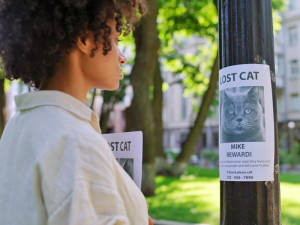Why You Should Get Your Cat Microchipped—Even If They Live Indoors
And how to make sure your kitty’s is up to date if they already have one.

Share Article
I was getting ready for bed a few weeks ago, when I heard a woman calling out: “Joey? Joey? Joeeeeey!”
In New York, you learn to tune out screaming people, but this woman sounded desperate, and she was loud. Really loud.

littleKin™ is Kinship’s home just for puppy and kitten parents. Bop over to check out expert advice, new pet tools, and special deals—all curated for your newest family member.
opens in a new tabI looked out my bedroom window, into that strange no-man’s land that exists in the middle of all New York City blocks, where the back of every building stops just short of its lot’s property line, leaving an irregularly shaped area where ground floor businesses keep their garbage bins between pickup days. I couldn’t see her, but she continued to cry out, sounding progressively more and more distressed.
“Joey! Where are you, baby?”
“Shut the f*ck up!” yelled one of my neighbors from their window.
“Joey! Joeeeeey!” the woman continued.
“Shut up!” the man yelled again.
“ My cat is missingopens in a new tab!” the woman yelled back, true panic in her voice. “What am I supposed to do? Joey! Joeeeeey! Come back to Mommy!”
She cried out for another 10 minutes before her voice broke.
The next day, I heard her calling for Joey from the front of the building as she circled the block. That night, she was back behind my building. And again the night after that.
I couldn’t help her. I never actually saw her, only heard her wailing, and I had no idea which of the hundreds of apartments on my block belonged to her. There was nothing I could do, and, I suspected, she was already doing everything she could. All I could think was: I hope Joey has a microchip.
Microchips are incredibly important — here’s why.
Microchips linkopens in a new tab a human’s contact information to their cat’s physical body with a unique alphanumeric code. Vets, rescuers, and animal control officers who encounter the wayward feline can scan them, search the code in a national database, find out who the cat belongs to, and make contact.
“The microchip is inserted under the surface of the skin by a large diameter, very sharp needle,” says veterinarian Dr. Wendy Hauseropens in a new tab, founder of Peak Veterinary Consulting and special advisor to the ASPCA Pet Health Insurance program. “Most cats tolerate this procedure well, with discomfort often limited to the same amount as a vaccination when the chip is inserted. Because it is a larger-sized needle, I prefer the cat to be about three pounds or 12 weeks old.”
When performing the procedure, Dr. Hauser shaves off a small patch of fur, disinfects the skin, inserts the chip, and applies a drop of surgical glue, which speeds up the healing process and prevents the chip from accidentally migrating out of the opening in the skin.
“I often insert microchips in cats when they are being spayed or neutered, at around five to six months of age,” Dr. Hauser says. “The risk factor in waiting that long is if the kitten escapes the house; without a microchip, it may be harder to recover the lost pet.”
A collar and tag can be helpful too, but, as Dr. Hauser points out, few cats actually wear them and when they do, “the collars are often of a break-away design to prevent accidental strangulation if the cat’s collar is caught on something.”
A microchip, on the other hand, is part of the cat forever. “As a best practice, your pet’s microchip should be scanned with every veterinary visit [to ensure it is still functioning properly],” Dr. Hauser says. “But it is exceedingly uncommon for the chip to stop working or need replacement. I have only seen this once in my 25 years as a clinical veterinarian.”
The important thing is that you register your microchip and keep your contact information current. Gwendolyn Mathers, acting executive director of Tail Town Catsopens in a new tab cat cafe and adoption center in Pasadena, California recommends registering your information with the microchip company itself and with a national database like the National Microchip Registryopens in a new tab.
“I also recommend keeping your contact current with the rescue organization that you adopted from,” she says. “Some rescues may be watermarked on the microchip and they can help if the animal is lost and scanned while you are traveling or moving, since that is when most cats go missing.”
Please, just get the microchip.
Once the microchip is placed and the injection site heals, your cat should never even know the chip is there. “It’s smaller than a grain of rice,” Mathers says. ”You can sometimes feel the chip, but you have to really search for it.”
It’s also a relatively cheap procedure, compared to most veterinary interventions, usually costing about $50 to $70, depending on your vet. A small price to pay to dramatically increase the likelihood of being reunited with your pet.
I don’t know if Joey and his person ever reunited, but after the third night, I didn’t hear her calling out for him anymore. Until that moment, I don’t think it ever really occurred to me that an apartment cat would even need a microchip. Not in New York City. Microchips always seemed like more of a suburban thing. A house thing. An outdoor cat thing. And the vast majority of NYC apartments are two to 40 floors up with zero access to outdoor space.
But, still, Joey got out. Cats are curious creatures, and where there’s a will, there’s a way. All I know is that I’ll definitely be microchipping my own cats from now on.

Charles Manning
Charles Manning is an actor, writer, and fashion/media consultant living in New York City with his two cats, Pumpkin and Bear. Follow him on Instagram @charlesemanningopens in a new tab.
Related articles
![adventure cat walking on a bridge in harness and leash]() opens in a new tab
opens in a new tabCould Your Cat Be an Adventure Cat?
How you can train your cat to explore the great outdoors.
![Cat sitting in a field wearing a pink harness and leash.]() opens in a new tab
opens in a new tabThe Best Cat Harnesses of 2025
Safe and stylish gear to turn your local trail into a catwalk.
![Training a cat sitting with leash and harness on.]() opens in a new tab
opens in a new tabA Step by Step Guide on How to Clicker Train Your Cat
This popular training technique isn’t just for dogs. Here’s how you can use it for your cat.
![Sad woman looking for her lost cat, hanging posters with missing pet photo.]() opens in a new tab
opens in a new tabDo You Have a Lost Cat? Here Are the 8 Steps to Take Right Now
Follow these expert tips so your bestie can come home ASAP.
![a dog with a person mixing chocolate]() opens in a new tab
opens in a new tabThe Top 10 Toxins Pets Are Exposed to at Home, According to New ASPCA Report
These are the most common reasons pet parents call poison control.
![Cat eating out of metal bowl]() opens in a new tab
opens in a new tabTop 10 Foods That Are Toxic to Cats
Sharing isn’t always caring. Keep your cat safe by keeping these human snack staples to yourself.







